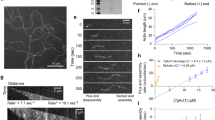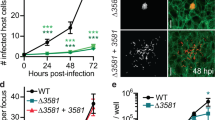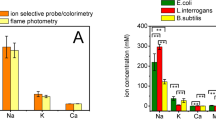Abstract
Actin polymerization is essential for cell locomotion and is thought to generate the force responsible for cellular protrusions. The Arp2/3 complex is required to stimulate actin assembly at the leading edge in response to signalling1,2,3,4,5,6. The bacteria Listeria and Shigella bypass the signalling pathway and harness the Arp2/3 complex to induce actin assembly and to propel themselves in living cells7,8,9,10. However, the Arp2/3 complex alone is insufficient to promote movement. Here we have used pure components of the actin cytoskeleton to reconstitute sustained movement in Listeria and Shigella in vitro. Actin-based propulsion is driven by the free energy released by ATP hydrolysis linked to actin polymerization, and does not require myosin. In addition to actin and activated Arp2/3 complex, actin depolymerizing factor (ADF, or cofilin) and capping protein are also required for motility as they maintain a high steady-state level of G-actin, which controls the rate of unidirectional growth of actin filaments at the surface of the bacterium. The movement is more effective when profilin, α-actinin and VASP (for Listeria) are also included. These results have implications for our understanding of the mechanism of actin-based motility in cells.
This is a preview of subscription content, access via your institution
Access options
Subscribe to this journal
Receive 51 print issues and online access
We are sorry, but there is no personal subscription option available for your country.
Buy this article
- Purchase on Springer Link
- Instant access to full article PDF
Prices may be subject to local taxes which are calculated during checkout


Similar content being viewed by others
References
Machesky,L. M. & Insall,R. H. Scar1 and the related Wiskott-Aldrich syndrome protein WASP regulate the actin cytoskeleton through the Arp2/3 complex. Curr. Biol. 8, 1347–1356 (1998).
Machesky,L. M. et al. Scar, a WASP-related protein, activates dendritic nucleation of actin filaments by the Arp2/3 complex. Proc. Natl Acad. Sci. USA 96, 3739–3744 (1999).
Rohatgi,R. et al. The interaction between N-WASP and the Arp2/3 complex links Cdc42-dependent signals to actin assembly. Cell 97, 221–231 (1999).
Winter,D., Lechler,T. & Li,R. Activation of the Arp2/3 complex by Bee 1p, a WASP-family protein. Curr. Biol. 9, 501–504 (1999).
Yarar,D., To,W., Abo,A. & Welch,M. D. The Wiskott-Aldrich syndrome protein directs actin-based motility by stimulating actin nucleation with the Arp2/3 complex. Curr. Biol. 9, 555–558 (1999).
Svitkina,T. M. & Borisy,G. G. Arp2/3 complex and Actin Depolymerizing Factor/cofilin in dendritic organization and treadmilling of actin filament array in lamellipodia. J. Cell Biol. 145, 1009–1026 (1999).
Theriot,J. A., Mitchison,T. J., Tilney,L. G. & Portnoy,D. A. The rate of actin-based motility of intracellular Listeria monocytogenes equals the rate of actin polymerisation. Nature 357, 257–260 (1992).
Welch,M. D., Iwamatsu,A. & Mitchison,T. J. Actin polymerization is induced by Arp2/3 protein complex at the surface of Listeria monocytogenes. Nature 385, 265–269 (1997).
Welch,M. D., Rosenblatt,J., Skoble,J., Portnoy,D. A. & Mitchison,T. J. Interaction of human Arp2/3 complex and the Listeria monocytogenes ActA protein in actin filament nucleation. Science 281, 105–108 (1998).
Egile,C. et al. Activation of the Cdc42 effector N-WASP by the Shigella IcsA protein promotes actin nucleation by Arp2/3 complex and bacterial actin-based motility J. Cell Biol. 146, 1319–1332 (1999).
Miki,H., Sasaki,T., Takai,Y. & Takenawa,T. Induction of filopodium formation by a N-WASP-related actin-depolymerizing factor. Nature 391, 93–96 (1998).
Suzuki,T., Miki,H., Takenawa,T. & Sasakawa,C. Neural Wiskott-Aldrich syndrome protein is implicated in the actin-based motility of Shigella flezneri. EMBO J. 17, 2767–2776 (1998).
Laurent,V. et al. Role of the proteins of the Ena/VASP family in actin-based motility of Listeria monocytogenes. J. Cell Biol. 144, 1245–1258 (1999).
Small,J. V. Getting the actin filaments straight: nucleation-release or treadmilling. Trends Cell Biol. 5, 52–55 (1995).
Carlier, M.-F. & Pantaloni,D. Control of actin dynamics in cell motility. J. Mol. Biol. 269, 459–467 (1997).
Carlier, M.-F. Control of actin dynamics. Curr. Opin. Cell Biol. 10, 45–51 (1998).
Carlier, M.-F. et al. Actin Depolymerising Factor (ADF/cofilin) enhances the rate of filament turnover: implication in actin-based motility. J. Cell Biol. 136, 1307–1322 (1997).
Didry,D., Carlier, M.-F. & Pantaloni,D. Synergy between ADF and profilin in enhancing actin filament turnover. J. Biol. Chem. 273, 25602–25611 (1998).
Ressad,F., Didry,D., Egile,C., Pantaloni,D. & Carlier, M.-F. Control of actin filament length and turnover by actin depolymerizing factor (ADF/cofilin) in the presence of capping proteins and Arp2/3 complex. J. Biol. Chem. 274, 20970–20976 (1999).
Nanavati,D., Ashton,F. T., Sanger,J. M. & Sanger,J. W. Dynamics of actin and α-actinin in the tails of Listeria monocytogenes in infected PtK2 cells. Cell Motil. Cytoskel. 28, 346–358 (1994).
Smith,G. A., Theriot,J. A. & Portnoy,D. A. The tandem repeat domain in the Listeria monocytogenes ActA protein controls the rate of actin-based motility, the percentage of moving bacteria and the localization of VASP and profilin. J. Cell Biol. 35, 647–660 (1996).
Lasa,I. et al. Identification of two regions in the N-terminal domain of ActA involved in the actin tail formation by Listeria monocytogenes. EMBO J. 16, 1531–1540 (1997).
Goldberg,M. & Theriot,J. A. Shigella flexneri surface protein IcsA is sufficient to direct actin-based motility. Proc. Natl Acad. Sci. USA 92, 6572–7576 (1995).
Kocks,C. et al. The unrelated surface proteins ActA of Listeria monocytogenes and IcsA of Shigella flexneri are sufficient to confer actin-based motility on Listeria innocua and E. coli respectively. Mol. Microbiol. 18, 413–423 (1995).
Cunningham,C., Stossel,T. P. & Kwiatkowski,D. Enhanced motility in NIH 3T3 fibroblasts that overexpress gelsolin. Science 251, 1233–1236 (1991).
Hug,C. et al. Capping protein levels influence actin assembly and cell motility in Dictyostelium. Cell 81, 591–600 (1995).
Sun,H., Kwiatkowska,K., Wooten,D. & Yin,H. Effects of CapG overexpression on agonist-induced motility and second messenger generation. J. Cell Biol. 129, 147–156 (1995).
Marchand, J.-B. et al. Actin-based movement of Listeria monocytogenes: actin assembly results from the local maintenance of uncapped filament barbed ends at the bacterium surface. J. Cell Biol. 130, 331–343 (1995).
Rottner,K., Behrendt,B., Small,J. V. & Wehland,J. VASP dynamics during lamellipodia protrusion. Nature Cell Biol. 1, 321–322 (1999).
Goldberg,M. Shigella actin-based motility in the absence of vinculin. Cell Motil. Cytoskel. 37, 44–53 (1997).
Kuhlmann,P. A. & Fowler,V. M. Purification and characterization of an α1β2 isoform of CapZ from human erythrocytes: cytosolic location and inability to bind to Mg++ ghosts suggest that erythrocyte actin filaments are capped by adducin. Biochemistry 36, 13461–13472 (1997).
Acknowledgements
We thank V. Laurent and C. Egile for discussion, D. Didry for Arp2/3 complex purification, and F. Ressad for human ADF. We acknowledge partial support from the Association pour la Recherche contre le Cancer, the Association Française contre les Myopathies and a Human Frontier in Science grant. T.P.L. is supported by a fellowship from the Natural Sciences and Engineering Research Council of Canada.
Author information
Authors and Affiliations
Corresponding author
Rights and permissions
About this article
Cite this article
Loisel, T., Boujemaa, R., Pantaloni, D. et al. Reconstitution of actin-based motility of Listeria and Shigella using pure proteins. Nature 401, 613–616 (1999). https://doi.org/10.1038/44183
Received:
Accepted:
Issue Date:
DOI: https://doi.org/10.1038/44183
This article is cited by
-
Biochemical and mechanical regulation of actin dynamics
Nature Reviews Molecular Cell Biology (2022)
-
Structure and function of an atypical homodimeric actin capping protein from the malaria parasite
Cellular and Molecular Life Sciences (2022)
-
A functional family of fluorescent nucleotide analogues to investigate actin dynamics and energetics
Nature Communications (2021)
-
Twinfilin uncaps filament barbed ends to promote turnover of lamellipodial actin networks
Nature Cell Biology (2021)
-
Mechanistic insight into bacterial entrapment by septin cage reconstitution
Nature Communications (2021)
Comments
By submitting a comment you agree to abide by our Terms and Community Guidelines. If you find something abusive or that does not comply with our terms or guidelines please flag it as inappropriate.



